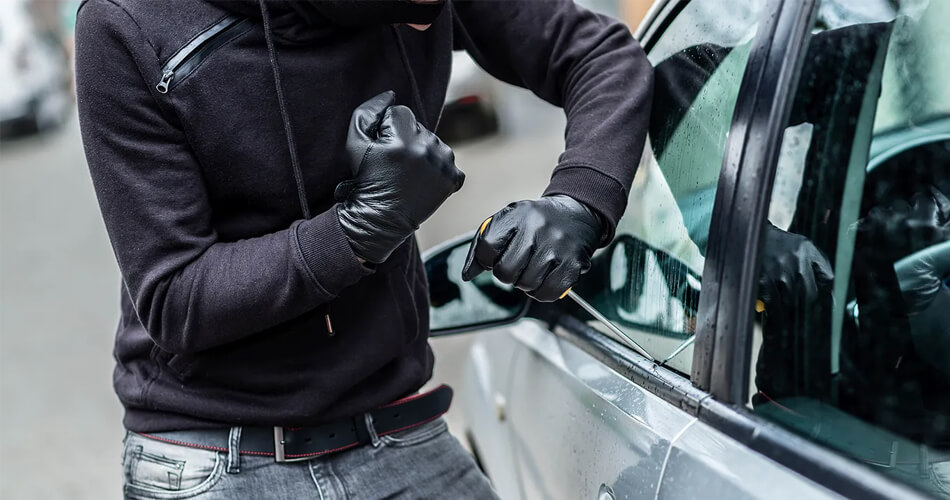Since the 1990s, vehicle thefts and burglaries have trended downward, to less than 800,000 in 2019. Yet 2020 saw a sharp increase in car thefts and burglaries, and the trend has continued into 2021. It’s not just cars being stolen, but specific parts on a vehicle, as well.
Contents
Theft of catalytic converters rose sharply in 2020, from an average of 282 converters stolen per month to 1,203 in 2020 – a rise of nearly 327%. What could be causing this rise in thefts? We dig into the contributing factors to this trend below.
Reasons Car Thefts and Burglaries Are Rising
1. The COVID-19 Pandemic
One big contributing factor to this rise in auto thefts and burglaries is the COVID-19 pandemic. Economic downturns like the one that resulted from the pandemic often create financial desperation that might motivate some people to steal assets that they can sell for cash, whether it’s the car itself, or parts on the car, or items that have been left in a car, like a backpack, laptop, or another valuable.
Another factor during the COVID-19 pandemic was that during the peak severity when infection rates were high, many people were also trying to avoid public transit, which may have been another motivating factor for car thefts.
2. The Rising Demand for Precious Metals
One factor driving theft of car parts, in particular, is the rising demand for precious metals: palladium, rhodium and platinum. These are the metals used to manufacture catalytic converters, the part on an engine that manages exhaust emissions. With metal prices soaring due to increased demand, thefts of catalytic converters have soared, with thieves typically selling the stolen parts for scrap. A catalytic converter is located on the underside of a car, in the exhaust system between the manifold and the muffler.
Vehicles that have higher ground clearance, like a pickup truck, make it easier for thieves to access the catalytic converter and remove it. Hybrid vehicles are also frequent targets for catalytic converter theft because theirs tend to be in better condition, due to reduced use of gasoline compared to other vehicles.
There are two ways to tell if your catalytic converter has been stolen. First, if you turn on your engine and it is suddenly much louder than usual and the exhaust coming from your tailpipe is smoky, this could be the result of a missing catalytic converter. Second, thieves steal the catalytic converter by cutting off the pipes on either end of it. If you look beneath your vehicle and see two severed pipes with no converter, it’s been stolen. (If you’re not sure what you’re looking for, try searching the internet for photos of the undercarriage for your car’s specific make and model, e.g., “2018 Toyota Prius undercarriage.”)
3. The Key Fob Problem
Many newer cars do not require a manual key to start the engine, but instead use a keyless ignition that come with a key fob. As long as the fob is in proximity to the car’s computer system, the car can be turned on with the push of the button, thanks to an embedded microchip in the fob that validates the signal. At first, this technology drove a steep decline in car thefts, but recent reports show that one big contributing factor to the rise in car thefts is how often vehicle owners forget to take the key fob with them when they leave exit the car, typically leaving it in the cupholder for anyone to find. In other words, stealing a car has never been easier for a thief. If you own a car with keyless ignition, never leave your key fob in the vehicle, even if you think you’ll only be out of the car a few minutes.
What to Do if Your Car has been Stolen
1. File a report with law enforcement. Your auto insurer will not be able to honor the claim if a police report has not been filed.
2. Contact your auto insurer to inform them of the missing vehicle.
What to Do if Your Car is Burgled
If your car has been broken into or you suspect that a part such as the catalytic converter has been stolen and you want to file an insurance claim, we recommend taking these steps:
1. Document the damage for your auto insurance provider.Documenting the damage with your smartphone will help speed up the process of filing a claim with your auto insurance and seeking repairs from an auto body shop near you. Proceed with caution if there is broken glass.
2. File a report with law enforcement.
3. Contact your auto insurer to inform them of the incident. If the damage is covered, ask if you can submit photos and video of the damage, as well as documentation.
4. Find an auto body or auto glass shop near you to repair the damage. If your car has been damaged, such as a shattered window, or damaged door or handle, you can contact an auto body or auto glass shop near you to discuss possible repairs. Ask if they accept digital photos of vehicle damage to generate a virtual estimate and kick off the repair process. Professional auto body and auto glass technicians can help restore your vehicle to pre-theft condition.
